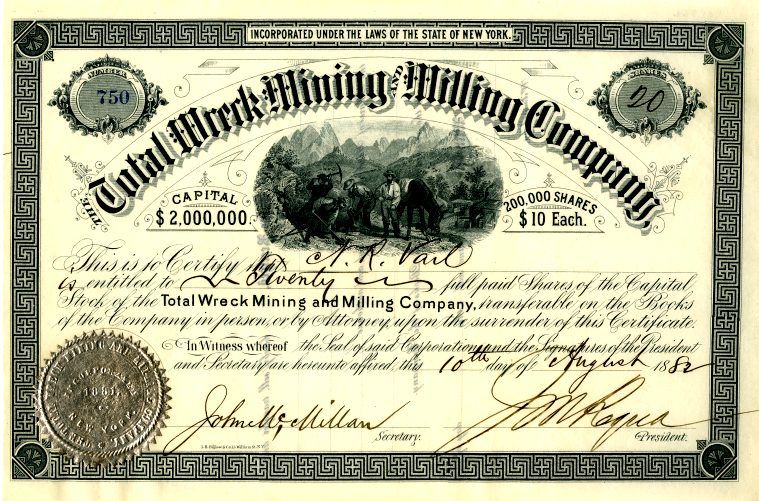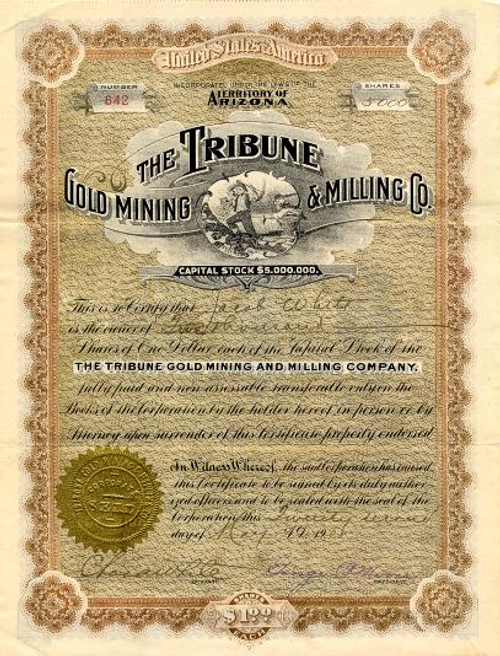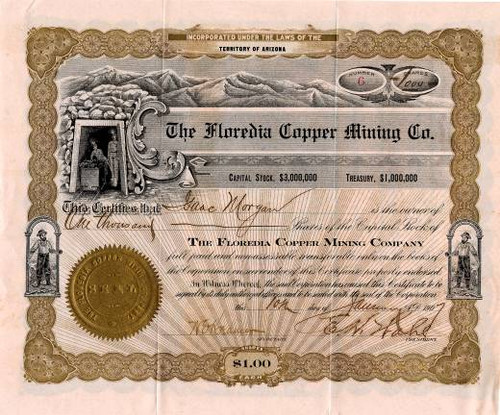Beautifully engraved certificate from the Total Wreck Mining and Milling Company issued in 1882. This historic document has an ornate border around it with a vignette of vignette of exploring miners. This item has the signatures of the Company's President, J.M. Requa and Secretary, John McMillan. Issued to Nathan R. Vail. This rare certificate is in mint condition. Mine was located in Arizona and the company was incorporated in New York.

Certificate
Total Wreck is a ghost town in Pima County, Arizona. John L. Dillon, the owner of the claims, named the townsite Total Wreck because he thought that the mine was on a ledge that looked like "a Total Wreck" because it was below a quartzite ledge with large boulders of quartzite strewn all over. The mine and its operations spawned the town around it, which had a post office and 4 saloons. The mine's founders were Walter Vale, and J.T. Dillon, and was noted for its rich silver production in its heyday. Black borders and a central vignette of exploring miners. The stock measures 10" x 6.70". Nathan R. Vail (1825-1888), a noted rancher, cattleman, and businessman, was one of the owners of the Total Wreck mine. He was the uncle of Walter L. Vail (1852-1906), who became a major figure in the Arizona cattle industry and owner of the famous Empire Ranch, was a co-owner of the Total Wreck mine along with his uncle. Now a ghost town, Total Wreck was a mining town established in Pima County in 1879 by John Dillon, the discoverer of the mine. According to legend, Dillon named the mine Total Wreck because he thought the mineral formation on the claim looked like a "total wreck." The claim was located on the was located on the Walter Vail's Empire Ranch and the silver mine made the wealthy Vail family more wealthy, generating more than $500,000 in profits. By 1884 the mine was in decline and by 1890 Total Wreck was well on its way to becoming a ghost town.. This rare certificate is in mint condition.
Nathan Randolph Vail (1825 – March 5, 1888) was a mine operator in Arizona Territory, and a landowner in 19th century Los Angeles, California. He was a member of the Los Angeles Common Council, the legislative body of the city.
Vail was born in New Jersey about 1825. He was married to Anna Walker Vail of Nova Scotia, and they had four children, Hugh W., John R., Lizzie H. (Mrs. Walter Irving Allen) and Frederick H.
His drowning death on March 5, 1888 resulted from an inspection trip he was making of his property at Redondo Beach, California, where he was a director of the Redondo Beach (development) Company: A coroner's jury heard testimony on March 6 that he had been warned against making the short passage aboard a flat-bottomed skiff in a rough surf from the shore to a vessel lying at anchor off the coast, but he replied that he was "an old sea captain" and insisted upon the crossing. A huge wave pitched him and three sailors into the sea: He was wearing a heavy coat and drowned; the lightly clad crew survived.
Vail's investments included "large holdings in land and water properties, and cattle and ranching interests both in California and Arizona." He also owned a business in Total Wreck, Arizona.
In 1887 Vail was elected treasurer of a nonprofit corporation "to secure and hold" property of the Episcopal Church in Southern California.
That same year Vail, along with Judge Charles Silent and D. McFarland, bought a 1,400-acre plot of Rancho San Pedro, an area known as the Dominguez Property and Salt Works, including a 1-1/2-mile frontage along the beach, back a half mile to an elevation of 600 feet. "The surface is thus beautifully diversified and rolling, thus affording a view of surpassing loveliness and grandeur for miles in all directions, including Los Angeles, Ballona and the whole valley." A first-class hotel, new streets and other improvements were planned.
After Vail's death, his estate was sued by L. J. Rose, who claimed that he had bought half of Vail's shares in the '49 Mining Company of Arizona for $4,000, but the shares were neither delivered nor the money refunded.
Vail represented the 5th Ward on the Los Angeles Common Council, the legislative branch of city government, during 1878–79.
History from Wikipedia and OldCompany.com (old stock certificate research service)








